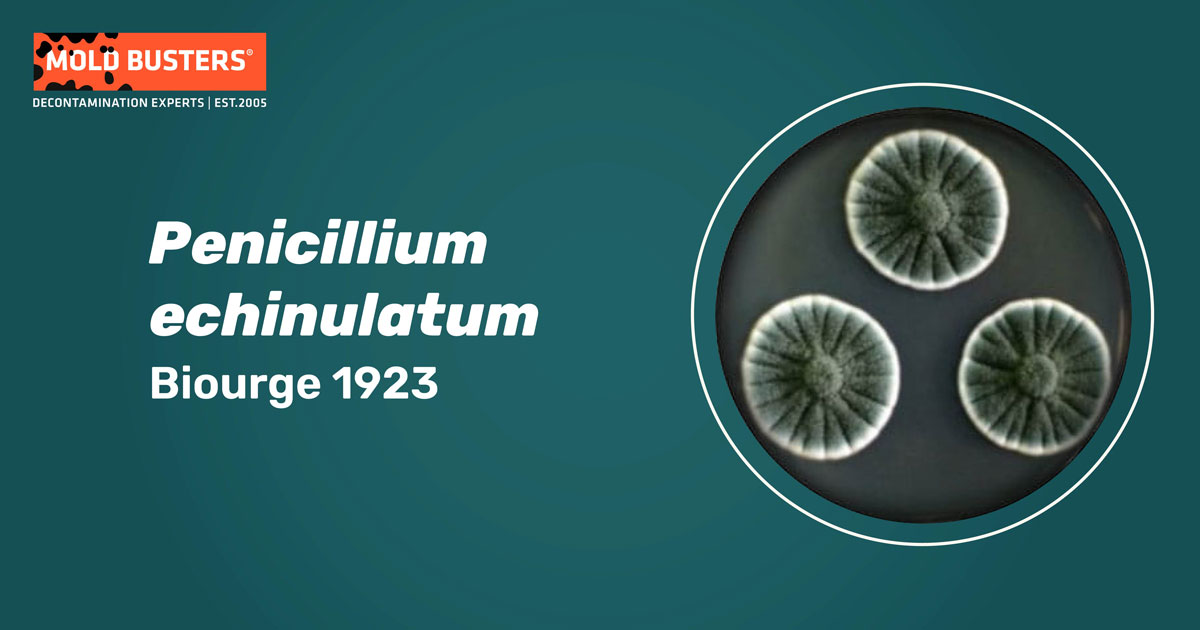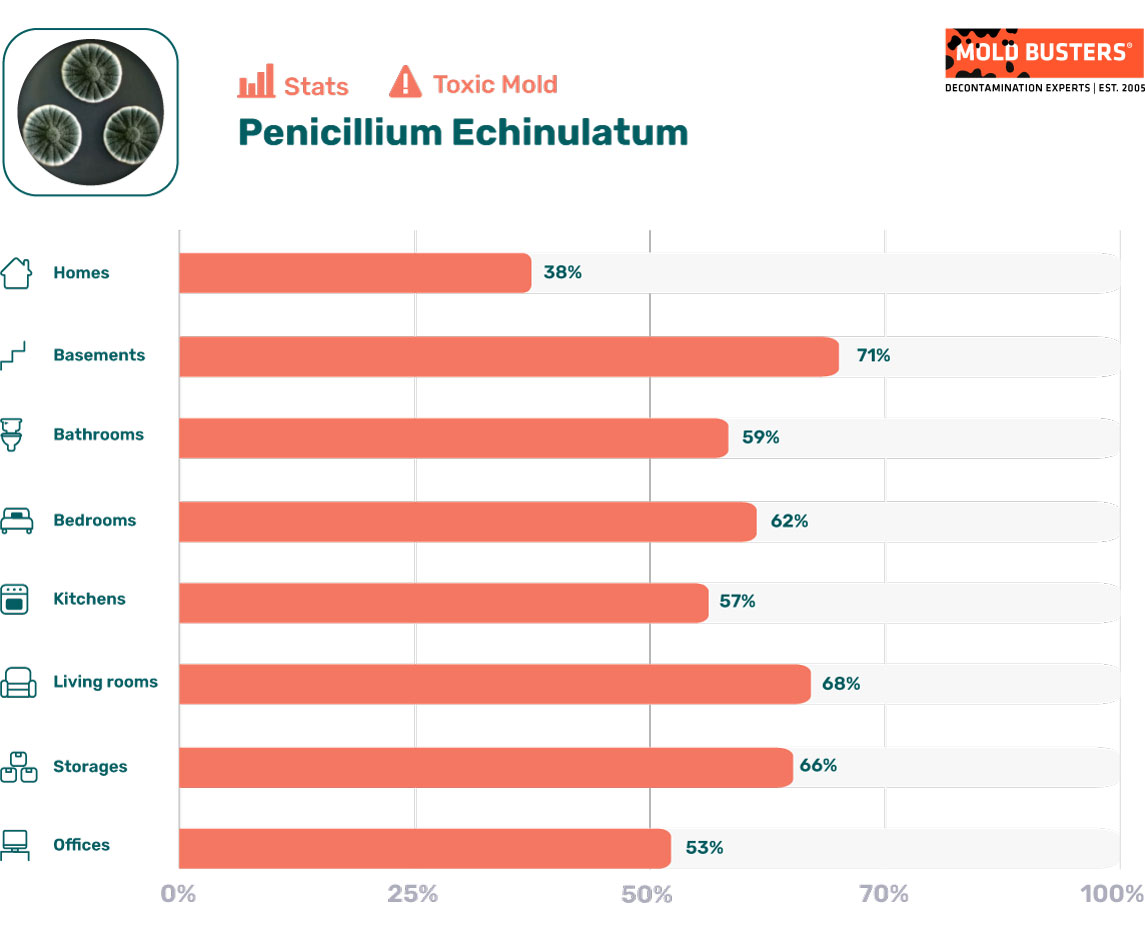Biourge 1923
Penicillium echinulatum is a member of the well-known genus Penicillium, which contains over 300 species of fungi. As saprophytic fungi, they have an important role in the cycle of organic and inorganic materials through decomposition. In fact, one of the most frequent causes of food spoilage are of members of the Penicillium genus (1,2).

Penicillium echinulatum ecology
Most Penicillium species can be isolated from wherever organic material is present and are almost universal in most soils. They prefer dark, moist and cool locations. In fact, according to the CDC (Center for Disease Control and Prevention), Penicillium sp. is one of the three most common indoor molds found in our houses, besides Cladosporium and Aspergillus (3).
Penicillium echinulatum enzymes
Apart from the negative effects of Penicillium on our everyday life, we have learned to benefit from these fungi. Many branches of industry have learned to harness the powerful biochemical machinery found in these fungi. Penicillium echinulatum is one of these fungi that are proving to be more and more useful in many aspects of our lives (4).
Currently, there is a great interest in cellulases enzymatic complex produced by the P. echinulatum for applications in different industries, such as food, alcohol, pulp and paper, textile, detergent, and agriculture industries. This enzymatic machinery is a synergy of enzymes composed of endoglucanase, exoglycanase, and β-glucosidase that degrade cellulose (4,5).
Penicillium echinulatum mold statistics
As part of the data analysis presented inside our mold statistics resource page, we have calculated how often mold spore types appear in different parts of the indoor environment when mold levels are elevated. Below are the stats for Penicillium echinulatum:


Penicillium echinulatum applications in bio-technology
Cellulose is a complex sugar composed of repeated glucose units. The long-chain-cellulose polymers are linked together to form microfibrils. Cellulose microfibrils are packed tightly to prevent not only enzymes to pass through but even small molecules like water cannot enter the complex. Cellulase is packed with hemicellulose and lignin in a complex called lignocellulose which composes the dry plant matter (6). Arranged as such, lignocellulose gives to the plants its structural integrity, rigidity, and the ability to grow upwards. Fungi like P. echinulatum are capable of using their enzymes to penetrate the hard lignocellulose strains and get to the cellulose. Interestingly, the only organisms with the ability to dissolve lignocellulose and use it for nutrition are only fungi (and some bacteria).
As such, lignocellulose is one of the most abundantly available raw material on the planet. It holds great potential for producing biofuel (ethanol) as an alternative to fossil fuels. Its abundance aside, this material is also cheap, as it is an agricultural bi-product. Bio-fuel production is challenging and expensive to achieve on a large-industrial scale because sugars necessary for the fermentation of ethanol are trapped inside the lignocellulose molecules (6). Enzymes need to be produced that can penetrate the lignocellulose and release glucose monomers, which can only then be fermented and used for biofuel production. Industrial production of enzymes is timely, expensive, and often not friendly to the environment. Therefore, the potential use of P. echinulatum is very exciting, as it is among several organisms with high potential for the cheap and simple production of cellulases (6,7).
Bibliography
- Visagie CM, Houbraken J, Frisvad JC, Hong SB, Klaassen CH, Perrone G, Seifert KA, Varga J, Yaguchi T, Samson RA. Identification and nomenclature of the genus Penicillium. Studies in mycology. 2014; 78:343-71.
- Samson RA, Seifert KA, Kuijpers AF, Houbraken JA, Frisvad JC. Phylogenetic analysis of Penicillium subgenus Penicillium using partial β-tubulin sequences. Stud Mycol. 2004; 49(1):175-200.
- Basic Facts about Mold and Dampness | CDC [Internet]. Available from: cdc.gov
- Camassola M, Ramos De Bittencourt L, Shenem NT, Andreaus J, Pinheiro Dillon AJ. Characterization of the cellulase complex of Penicillium echinulatum. Biocatal Biotransformation. 2004; 22(5–6):391–6.
- Schneider WD, Gonçalves TA, Uchima CA, Couger MB, Prade R, Squina FM, Dillon AJ, Camassola M. Penicillium echinulatum secretome analysis reveals the fungi potential for degradation of lignocellulosic biomass. Biotechnology for biofuels. 2016; 9(1):1-26.
- Houghton J, Weatherwax S, Ferrell J. Breaking the biological barriers to cellulosic ethanol: a joint research agenda. EERE Publication and Product Library; 2006.
- Schneider WDH, dos Reis L, Camassola M, Dillon AJP. Morphogenesis and production of enzymes by Penicillium echinulatum in response to different carbon sources. Biomed Res Int. 2014; ID 254863.
- Six Species of Penicillium Associated with Blue Mold of Grape – Scientific Figure on ResearchGate. Available from: https://www.researchgate.net/ [accessed 11 Jun 2021]

Get Special Gift: Industry-Standard Mold Removal Guidelines
Download the industry-standard guidelines that Mold Busters use in their own mold removal services, including news, tips and special offers:

Written by:
Dusan Sadikovic
Mycologist – MSc, PhD
Mold Busters
Fact checked by:
Michael Golubev
General Manager
Mold Busters
